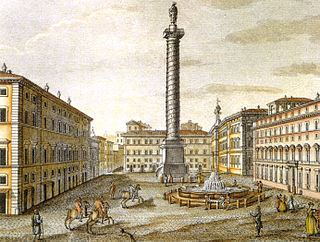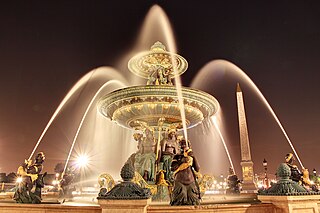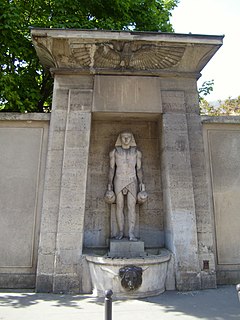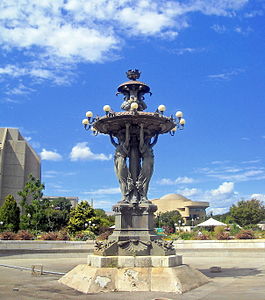History
The Crystal Fountain was designed by Follett Osler, it was the world's first glass fountain, made of four tons of pure crystal glass. [1] It was displayed in the central court of the Crystal Palace of the London Great Exhibition of 1851. It was destroyed by fire, along with the Crystal Palace, in 1936. The Art Journal Illustrated Catalogue of the Great Exhibition wrote in 1851 that the fountain was "perhaps the most striking object in the exhibition; the lightness and beauty, as well as the perfect novelty of the design, have rendered it the theme of admiration with all visitors. The ingenuity with which this has been effected is very perfect; it is supported by bars of iron, which are so completely embedded in the glass shafts, as to be invisible, and in no degree interfering with the purity and crystalline effect of the whole object. [2]
- The 1876 Centennial Exposition, in Philadelphia, celebrating the 100th birthday of the United States, featured the Bartholdi Fountain, made by the sculptor Frédéric Auguste Bartholdi, who later created the Statue of Liberty. Its vasque had a circle of gas lamps which shone on the cascading water, making it one of the first fountains to be illuminated. After the exposition the fountain was purchased by the United States Congress. It is now at the corner of Independence Avenue and First Street, in the United States Botanic Garden, on the grounds of the United States Capitol, in Washington, D.C.
Eight universal expositions took place in Paris between 1855 and 1937, and each included fountains, both for decoration and for sale, which demonstrated the latest in technology and artistic styles. They introduced illuminated fountains, fountains which performed with music, fountains made of glass and concrete, and modern abstract fountains to Paris.
- The Exposition Universelle (1889) which celebrated the 100th anniversary of the French Revolution. featured the Eiffel Tower, and a fountain illuminated by electric lights shining up though the columns of water, a method first developed in England in 1884. The fountains, located in a basin forty meters in diameter, were given color by plates of colored glass inserted over the lamps. The Fountain of Progress gave its show three times each evening, for twenty minutes, with a series of different colours. [3]
- The Exposition Universelle (1900) featured the Temple of Electricity, near the Champs Elysees, which had a series of illuminated fountains in front, with lamps shining blue, white and red light. The innovation of 1900 was a keyboard which allowed changing the colours in rapid succession. [4]
- The Exposition Internationale des Arts Décoratifs et Industriels Modernes (1925). This fair introduced the first fountains made of modern materials and in the modernist style of the 20th century. The fountain by sculptor Gabriel Guevrekian was composed of four triangular basins, colored blue or red, and a fountain of glass in the centre, surrounded by triangles of grass and flowers. It was the first fountain in Paris composed like a cubist painting.
The most original fountain in the exposition was Les Sources et les Rivières de France, made by René Lalique. It was a column of glass five meters high, made up of 128 caryatids of glass, each with a different decoration and size, each spraying a thin stream of water into the fountain below. At night the column was illuminated from within, and could change color. It was placed on a cross of concrete covered with decorated plates of glass, and in an octagonal basin also decorated with colored and black tiles of glass. [5]
- 'The Paris Colonial Exposition of 1931 introduced neon lights and the indirect outdoor lighting of Paris buildings, and featured eight different illuminated fountains.
- The Théâtre d'eau, or water theater, located on one side of the lake, covering an arc of a circle of about 80 meters, created a performance of dancing water, forming changing bouquets, arches, and curtains of water from its jets and nozzles. It was the ancestor of the modern musical fountain.
- The Pont d'eau was made by jets of water from both sides of Lake Daumesnil, which formed an illuminated water "bridge" forty meters long and six meters wide. [5]
- The Exposition Internationale des Arts et Techniques dans la Vie Moderne (1937) had fountains on both sides of the Seine, at the Trocadéro and on the Champ de Mars. Eight water jets were mounted on pontoons to form arches of water twenty meters long. and 174 submerged fountains were placed under the river surface. The choreography of the fountains was combined with light, and, for the first time, with music, amplified from loudspeakers from eleven rafts anchored in the river. The music featured compositions by the leading modern composers of the period, including Igor Stravinsky, Darius Milhaud, and Arthur Honegger.
The cascades, fountains and basins of the Jardins du Trocadéro, originally built for the 1878 exposition, were completely rebuilt for the 1937 exposition. The main feature was a long basin, or water mirror, with twelve fountain creating columns of water 12 meters high; twenty four smaller fountains four meters high; and ten arches of water. At one end, facing the Seine, were twenty powerful water cannon, able to project a jet of water fifty meters. Above the long basin were two smaller basins, linked with the lower basin by casades flanked by 32 sprays of water four meter high, in vasques. These fountains are the only exposition fountains which still exist today, and still function as they did.
The exhibit also featured two more unusual fountains; a fountain in the Spanish pavilion by the sculptor Alexander Calder, the Fontaine de Mercure, where a small metal structure created a flow of mercury, and a fountain of wine, imitating one once created for Louis XIV at Versailles.

Frédéric Auguste Bartholdi was a French sculptor and painter. He is best known for designing Liberty Enlightening the World, commonly known as the Statue of Liberty.

The Place de la Concorde is one of the major public squares in Paris, France. Measuring 7.6 ha in area, it is the largest square in the French capital. It is located in the city's eighth arrondissement, at the eastern end of the Champs-Élysées.

A fountain, from the Latin "fons", meaning source or spring, is a decorative reservoir used for discharging water. It is also a structure that jets water into the air for a decorative or dramatic effect.

The Jardin du Luxembourg, known in English as the Luxembourg Garden, colloquially referred to as the Jardin du Sénat, is located in the 6th arrondissement of Paris, France. Creation of the garden began in 1612 when Marie de' Medici, the widow of King Henry IV, constructed the Luxembourg Palace as her new residence. The garden today is owned by the French Senate, which meets in the Palace. It covers 23 hectares and is known for its lawns, tree-lined promenades, tennis courts, flowerbeds, model sailboats on its octagonal Grand Bassin, as well as picturesque Medici Fountain, built in 1620. The name Luxembourg comes from the Latin Mons Lucotitius, the name of the hill where the garden is located.

The Fontaine Bartholdi is a fountain sculpted by Frédéric Auguste Bartholdi and realised in 1889 by Gaget & Gautier. It was erected at the Place des Terreaux, in the 1st arrondissement of Lyon, in September 1892.

The fountain in the Piazza Colonna is a fountain in Rome, Italy, designed by the architect Giacomo Della Porta and constructed by the Fiesole sculptor Rocco Rossi between 1575 and 1577.

The Stravinsky Fountain is a whimsical public fountain ornamented with sixteen works of sculpture, moving and spraying water, representing the works of composer Igor Stravinsky. It was created in 1983 by sculptors Jean Tinguely and Niki de Saint Phalle, and is located on Place Stravinsky, next to the Centre Pompidou, in Paris.

The Medici Fountain is a monumental fountain in the Jardin du Luxembourg in the 6th arrondissement in Paris. It was built in about 1630 by Marie de' Medici, the widow of King Henry IV of France and regent of King Louis XIII of France. It was moved to its present location and extensively rebuilt in 1864-66.

The Fountains in Paris originally provided drinking water for city residents, and now are decorative features in the city's squares and parks. Paris has more than two hundred fountains, the oldest dating back to the 16th century. It also has more than one hundred Wallace drinking fountains. Most of the fountains are the property of the municipality.

The Bartholdi Fountain is a monumental public fountain, designed by Frédéric Auguste Bartholdi, who later created the Statue of Liberty. The fountain was originally made for the 1876 Centennial Exposition in Philadelphia, Pennsylvania, and is now located at the corner of Independence Avenue and First Street, SW, in the United States Botanic Garden, on the grounds of the United States Capitol, in Washington D.C.

The Fontaines de la Concorde are two monumental fountains located in the Place de la Concorde in the center of Paris. They were designed by Jacques Ignace Hittorff, and completed in 1840 during the reign of King Louis-Philippe. The south fountain commemorates the maritime commerce and industry of France, and the north fountain commemorates navigation and commerce on the rivers of France.
The Fountains of St. Peter's Square are two fountains in St. Peter's Square in Vatican City, created by Carlo Maderno (1612–1614) and Gian Lorenzo Bernini (1667–1677) to ornament the square in front of St. Peter's Basilica. The older fountain, by Maderno, is on the north side of the square.

The Fountain in Piazza Santa Maria in Trastevere is a fountain located in the square in front of the church of Santa Maria in Trastevere, Rome, Italy. It is believed to be the oldest fountain in Rome, dating back, according to some sources, to the 8th century. The present fountain is the work of Donato Bramante, with later additions by Gian Lorenzo Bernini and Carlo Fontana.

The Fontaine du Fellah, also known as the Egyptian Fountain, located at 52 rue de Sèvres in the 7th arrondissement of Paris, next to the entrance of the Vaneau metro station, was built in 1806 during the rule of Napoleon Bonaparte, in the neo-Egyptian style inspired by Napoleon's Egyptian campaign. It is the work of architect François-Jean Bralle and sculptor Pierre-Nicolas Beauvallet. It has been listed since 1977 as a monument historique by the French Ministry of Culture.

The Fontaine du Palmier (1806-1808) or Fontaine de la Victoire is a monumental fountain located in the Place du Châtelet, between the Théâtre du Châtelet and the Théâtre de la Ville, in the First Arrondissement of Paris. It was designed to provide fresh drinking water to the population of the neighborhood and to commemorate the victories of Napoleon Bonaparte. It is the largest fountain built during Napoleon's reign still in existence. The closest métro station is Châtelet

Jardins du Trocadéro is an open space in Paris, located in the 16th arrondissement of Paris, bounded to the northwest by the wings of the Palais de Chaillot and to the southeast by the Seine and the Pont d'Iéna, with the Eiffel Tower on the opposite bank of the Seine.

Fountains in France provided drinking water to the inhabitants of the ancient Roman cities of France, and to French monasteries and villages during the Middle Ages. Later, they were symbols of royal power and grandeur in the gardens of the kings of France. Today, though they no longer provide drinking water, they decorate the squares and parks of French cities and towns.




















